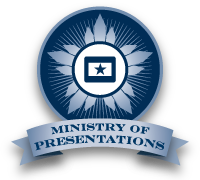In the event that you must create your presentation without qualified assistance from the Ministry, we have prescribed some best practices:
- Limit the fonts used to only one or two styles and colors. For example: one for main body/header text, and another for photo captions or diagrams.
- Adhere to a defined color palette for visual consistency throughout your document.
- For an on-screen presentation, don't be concerned with the number of slides as much as how much time you have. It is better to have a limited amount of text and information on the screen at one time, and click through several slides, than to pack one slide with twenty minutes' worth of different things you want to discuss and have the same cluttered slide on-screen during the whole time.
- Don't write lengthy slide headers. Keep these concise and use the rest of the slide to explain your point.
- Ensure that any visuals used support the point being made, and are not unnecessary "decoration." If your information is boring without putting meaningless boxes, arrows and lines around it, consider revising what you are presenting to make it less boring.
- Protect yourself legally: ensure any visuals you use are paid for or licensed and not copyrighted, and that sources are specified. You risk being sued otherwise (pulling images from Google is not recommended — the fact that they are "out on the Internet" does not make them public domain; they are still copyright protected).
- Avoid mixing illustration and photographic styles — for example, a cartoon on one page, black/white photo on another, color photos on another.
- When pasting content from other sources into a slide, ensure that the formatting matches the design of the destination document (in PowerPoint, you can control this by using the 'use destination theme' option or the 'paste special' command; in Keynote use the 'paste and match style' command). Your audience will appreciate that your presentation appears to be created especially for them, vs. one that looks hastily assembled from a variety of sources.
- Avoid using 3D chart features. They may look fancy, but they often make it more difficult to see data relationships and proportions.
- Use transitions and animations sparingly, and only as needed to support the point you are making. Avoid animating text in on a line-by-line basis.
Here's an interesting way to gauge the effectiveness of your presentation: notice how many people in the audience are checking their computers/phones or otherwise not looking at you while you're talking.
Remember WHY you're presenting — you're either educating your audience, or trying to convince them to spend money (or keep spending it). Especially when it's the latter, make sure your presentation is focused on solving your client's problem, rather than you or your firm. Clients care less about your process, methodology, or how experienced, global, etc. your company is than whether or not you're going to give them what they need.
© 2014 Ministry of Presentations. All rights reserved.

